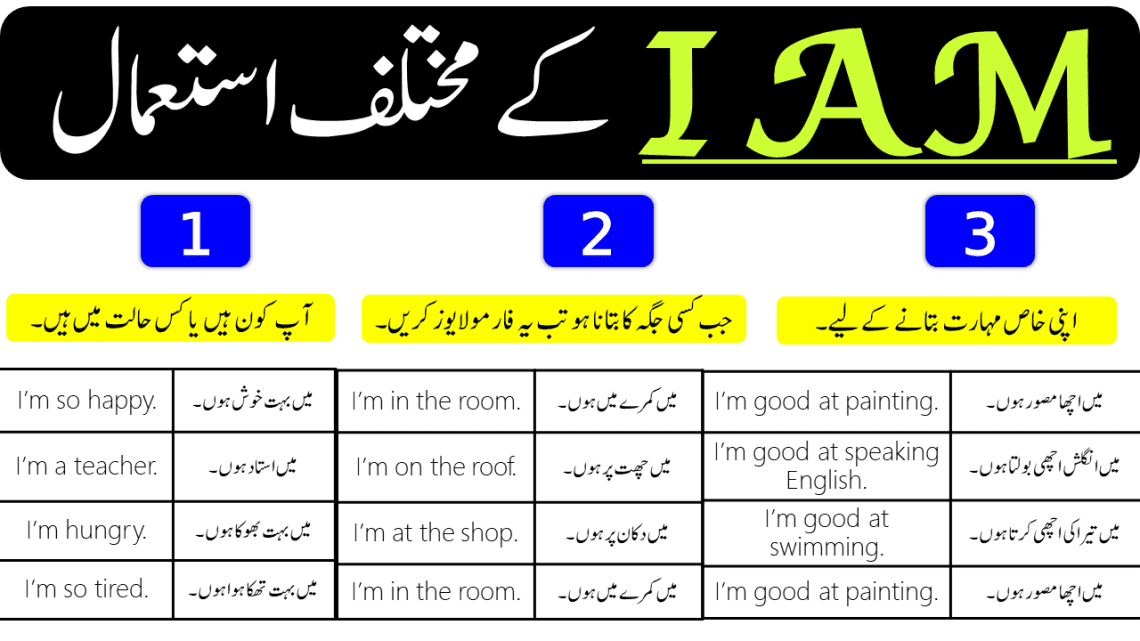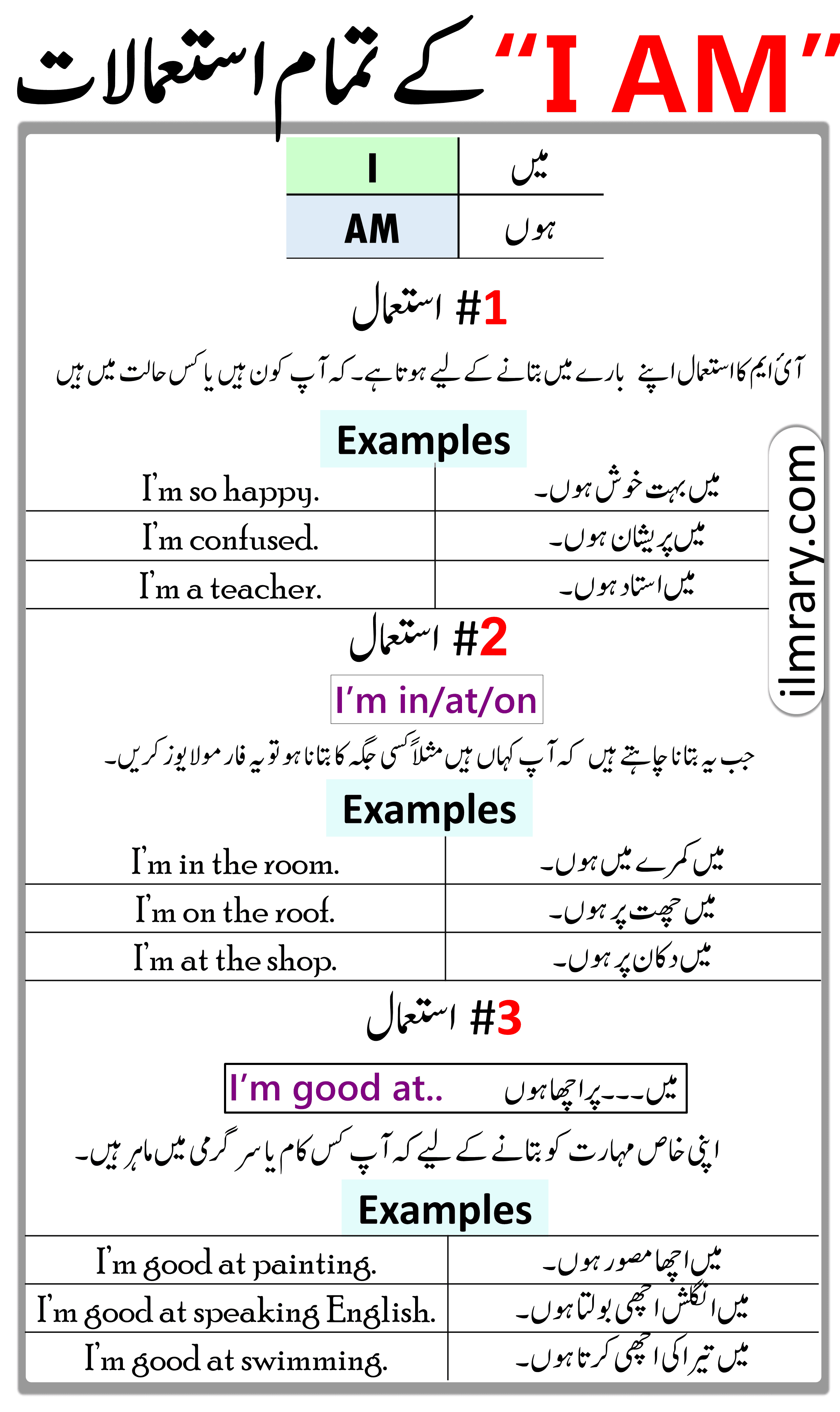The phrase “I am” is very important in English and is used in many different ways. It helps us talk about ourselves, describe how we feel, or explain what we do. Knowing how to use “I am” in different ways is a key part of learning English.
In this article, we will explore different uses of “I am” with their Urdu meanings. This will help you understand how to use “I am” in various situations, making your English speaking skills stronger and more natural.
Contents
Uses of I AM
1. Talking about Situations or Feelings
“I am” is used to talk about yourself, your feelings, or your profession. It’s a simple way to say who you are or how you feel at the moment. Here are a few examples:
آئ ایم کا استعمال اپنے بارے میں بتانے کےلئیے ہوتا ہے۔ کہ آپ کون ہیں یا کس حالت میں ہیں۔
Examples:
| I’m so happy. | میں بہت خوش ہوں۔ |
| I’m a teacher. | میں استاد ہوں۔ |
| I’m hungry. | میں بہت بھوکا ہوں۔ |
| I’m so tired. | میں بہت تھکا ہوا ہوں۔ |
Question Form:
- Am I good at?
کیا میں اچھا ہوں؟ - Negative Form:
I’m not (میں نہیں ہوں)
2. Using I’m in, I’m at, I’m on for Locations
When you want to describe where you are, you use “I am” with the prepositions in, at, or on. Here is how these prepositions are used:
جپ آپ یہ بتانا چاہتے ہیں کی آپ کہاں ہیں مثلا ً کسی جگہ کا بتانا ہو تو یہ فارمولا استعمال کر سکتے ہیں۔
Examples:
| I’m in the room. | میں کمرے میں ہوں۔ |
| I’m on the roof. | میں چھت پر ہوں۔ |
| I’m at the shop. | میں دکان پر ہوں۔ |
| i am in the office. | میں آفس میں ہوں۔ |
Explanation:
- In is used for closed spaces like rooms or buildings.
- At is used for specific places like shops or schools.
- On is used for surfaces like roofs or tables.
3. Expressing Skills or Talents with “I’m good at…”
You can use “I’m good at” to talk about things you are skilled at. This helps you describe your strengths or hobbies.
اپنی خاص مہارت کو بتانے کےلئیے کہ آپ کس کام یا سرگرمی میں ماہر ہیں یہ فارمولا استعمال کر سکتے ہیں۔
Examples:
| I’m good at painting. | میں اچھا مصور ہوں۔ |
| I’m good at speaking English. | میں انگلش اچھی بولتا ہوں۔ |
| I’m good at swimming. | میں تیراکی اچھی کرتا ہوں۔ |
Negative Form:
- I’m not good at…
میں اچھا نہیں ہوں۔
4. Short Answers in Spoken English
In everyday spoken English, short answers are often used. This makes communication quicker and easier.
سپوکن انگلش کو زیادہ مؤثر بنانے کےلئیے یہ طریقہ ضرور استعمال کریں جیسے انگریز کرتے ہیں۔
Examples:
| Are you a student? | Yes, I am | No I am not |
| Are you a player? | Yes, I am | No, I am not |
| Are you a good at writing? | Yes, I am | No, I am not |
Explanation:
- Yes, I am means you are confirming the statement.
- No, I am not means you are denying the statement.
Conclusion:
We’ve learned several important ways to use “I am” in English, including how to talk about your emotions, location, skills, and respond in short answers. Practice using these forms in different situations to improve your English and sound more fluent.
FAQs:
1. How do I use “I am” in English?
To use “I am”, follow it with a description of your feelings, profession, location, or talent. For example, “I’m a teacher” or “I’m happy.”
2. What does “I am good at” mean?
“I am good at” is used to talk about things you are skilled at, like painting or swimming. For example, “I’m good at playing soccer.”
3. Can I use “I am” for locations?
Yes! You can use “I am” with prepositions like in, at, and on to talk about where you are. For example, “I’m in the park” or “I’m at school.”
4. How do I make questions with “I am”?
To make questions with “I am”, simply invert the order. For example, “Am I late?” or “Am I good at swimming?”
5. How do I respond in short answers with “I am”?
For short answers, you can say “Yes, I am” or “No, I am not” to confirm or deny something. For example, “Are you a student?” Yes, I am.
You May Also Like
- Time Related Sentences
- Use of Since and For
- 45 Travel Sentences in English
- 180 English Sentences for Speaking
- 99 English Speaking Practice Sentences



